|

Welcome
|
|
|
|
|
|
|
|
|
|
|
|
|
|
|
|
|
|
|
|
|
|
|
|
|
|
|
|
|
|
|
|
|
|
|
|
|
|
|
|
|
|
|
|
|
|
|
|
|
|
|
|
|
|
|
|
|
|
|
|
Kathmandu
|
|
Information about Kathmandu |
|
Kathmandu, the capital of Nepal, is one of the most picturesque capitals in the world. The city of Kathmandu derives its name from Kasthamandap, an imposing wooden pagoda near the Hanuman Dhoka Palace. This city was built by King Gunakama Dev in 723 AD. The original name of the city was Kantipur, the glamorous city. Kathmandu is situated at an altitude of 1,336 m above sea level, and surrounded by high mountains all around, with the white peaks looking down and can be viewed clearly from vantage points at the foothills around Kathmandu. The city of Kathmandu covers an area of more than 300 square kms and situated in the Kathmandu valley which also houses several ancient towns, monuments and architectural wonders. The city of Kathmandu is a perfect mixture of the ancient, traditional and modern. Kathmandu is also the centre of all commercial, political, cultural and social activities and the tourist, adventure and mountaineering excursions. It is also the headquarters of the government of Nepal. Kathmandu has all the features that describe it as a truly modern city. The climate of Kathmandu is seldomly very cold for most of the year. The best time to visit Kathmandu is from September to November and February to May. |
|
|
|
History of
Kathmandu |
|
Kathmandu was founded in 723 AD by the Licchavi king Gunakama Dev at the confluence of the Bagmati and Bishnumati rivers. The original name of the city was Kantipur, the glamorous city. The hub of the city is the area around the oldest building, the Kastha Mandap, which stood at the crossroads of two important trade routes. When the valley was unified in the 14th century by Jayasthiti Malla, Kathmandu became the administrative centre and this sparked off an expansion that was sustained over many years. In the 19th century, due to the Rana's travels overseas, new European styles were introduced. Under the Ranas, various places were built at Patan
and Kathmandu, but with the return of the monarchy, these became
neglected. There are various attractions in the ancient city of
Kathmandu due to which various people came here as conquerors,
traders and businessmen, as seekers of adventure and economic
migrants.
|
|
|
|
Tourist Attractions in Kathmandu |
|
There are about 2000 temples and shrines in Kathmandu.
The most interesting things to see in Kathmandu are
clustered around the old towns between the old
marketplace and the shopping centre along the New Road. |
|
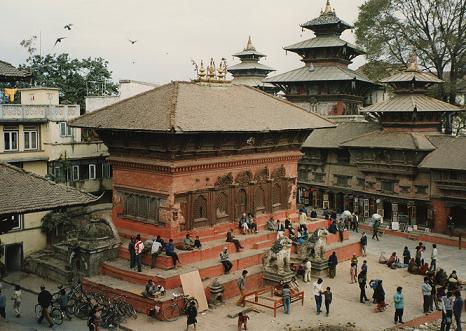
|
Durbar Square
Durbar Square is the spiritual heart of Kathmandu. Around central Durbar Square, there is the Royal Palace, palaces, pagodas, courtyards, temples and the Kumari House, the residence of the Living Goddess. The old royal palace is situated at the centre of the city and was surrounded by the temples and other important buildings. Many of the old buildings were re-built after the 1934 earthquake. The Durbar Square area comprises of 3 squares. The Kasthamandap (Wooden temple) is situated in the south west corner and one of the most famous building of Kathmandu. It was built in 1596 by Raja Lachmina Singh from the wood of one enormous sal tree. It was originally a rest house or community centre and later |
|
converted into a temple dedicated to Gorakhnath, whose shrine sits in the centre of a small enclosure. These temples were built between the 12th and 18th centuries by the Malla kings. On the north side of the square is the Ashok Binayak temple, also known as the Maru Ganesh. This small, golden temple is dedicated to the god Ganesh. The Maru Tole is located on the left side of the Ashok Binayak temple and leads to the Visnumati river and the Swayambhunath
temples. |
|
|
Swayambhunath
The Swayambhunath Stupa is the most important site of Buddhist worship in Nepal. This stupa is situated on the top of the Padmachala hill, 175 m above the valley and 3 km to the west of the city. This place was established over 2000 years ago by the King Manadeva I. A pre-Buddhist shrine in the form of a projecting stone was used as the central point of the
stupa. By 1234, Swayambhunath became an important centre of Buddhism learning and was closely related with
Lhasa. In the 14th century, the muslim troops from Bengal destroyed the shrine, but it was rebuilt and renovated by the Pratap Malla in the 17th century. This stupa can be reached by 400 steps built by Pratap
Malla. At the bottom of the stairs are three painted images erected by Pratap Malla and his fathers in 1637. At regular intervals are the pairs of eagles, lions, horses, peacocks and the vehicles of the Dhyani Buddhists. The stupa is about 20 m in diameter and 10 m
high. The white hemispherical mound represents
the four elements |
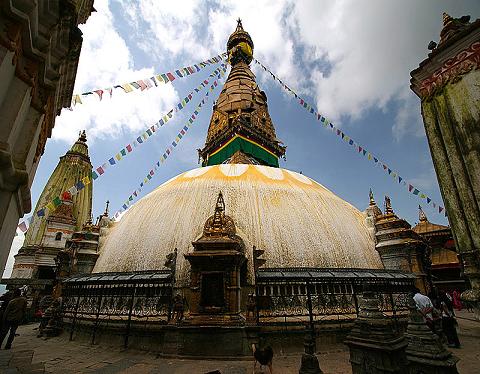
|
|
which are earth, water, wind and fire. Each side of the square stone has the eyes of Buddha. The third eye is the sign of true wisdom and the nose is in the form of a figure in Nepali. At the four cardinal points of the stupa are the four richly decorated niches that houses the Dhyani Buddhas in different meditation poses. Around the
stupa, the prayer wheels are turned by the faithful as they walk clockwise round the shrine. There is a great thunderbolt at the top of the stairs that symbolizes the male strength. It is accompanied by a bell which signifies female wisdom. |
|
|
|
|
Kumari Temple
The temple of the living goddess of Kumari is situated towards the Kumari Bahal and Kumari Chowk. The Hindus worship the goddess Kumari as the reincarnation of Siva's consort Parvati. The cult was instituted just over 200 years ago by Jaya Prakash Malla. The Kumaris are drawn from the Newar Sakya clan of gold and silversmiths and are initiated into the role at the age of 4 or 5. The living goddess Kumari is only allowed to witness the festivals and other religious occasions. During the festivals, the goddess is carried through the streets in a palanquin and walks on the cloth, as her feet must not touch the ground. The 18th century temple of the Living goddess Kumari and monastic courtyard is guarded at the entrance by two painted lions. The building is in the style of the Buddhist monasteries and was constructed in 1757 by Jaya Prakash Malla, as an act of the penance. The stucco facade has a number of intricately carved windows. The lintels are carved with laughing skulls while deities, doves and peacocks decorate the balcony windows. The walls of the courtyard have remarkable decoration. |
|
|
|
Excursions from Kathmandu
|
|
Besides visiting the above places, the tourists can also have one day excursion to various places nearby Kathmandu. Some of these places are Bodhnath, Pashupatinath Temple, Budhanikantha Temple and Dakshinkali
Temple. |
|
|
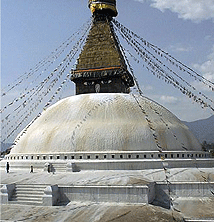
|
Bodhnath
Bodhnath is situated about 8 km. north-east of Kathmandu. The Bodhnath stupa is the largest stupa in Nepal that rises for 36 m. Bodhnath is situated on the ancient trade route between Kathmandu and
Lhasa. It is also believed that this stupa contains the bones of Kashyapa Buddha, who preceded Gautama Buddha. This stupa was built by Lichchavi king Mana Dev in the fifth century AD. The Bodhnath stupa is constructed on an octagonal base on a flat land in the centre of the Tibetan settlement. The hemispherical dome is topped by the square structure and above it rises the steps of enlightenment to the umbrella of Nirvana. Painted above are the all-seeing eyes of Lord Buddha.
The 108 images of the Dhyana Buddha are situated around
the octagonal base and is surrounded by a wall with 147
niches, each nich holds 4 to 5 prayer wheels. On the
|
|
wheels,
the hundreds of notes bear the Buddhist mantra 'Om
Mane Padme Hum'. With the each turn of the wheel,
the hundreds of messages are symbolically sent
into the heaven. There is a Buddhist monastery
near the stupa, where you can see many Tibetan
monks who come here to study. |
|
|
|
|
Pashupatinath Temple
The Pashupatinath Temple is situated about 5 kms. north east of Kathmandu and near the airport. The Pashupatinath temple is one of the most famous and holiest Hindu pilgrimage shrines in Nepal. This temple is dedicated to Lord Shiva, in his peaceful form as Mahadev and
Pashupati, the shepherd or lord of the beasts and situated on the banks of the Bhagmati River. This temple is visited by Hindus from all over the Indian subcontinent and closely associated with the South Indian Shaivism since the visit of
Shankaracharya. This late 17th century temple is a pagoda of brass and gilt with the silver plated gateways. The black, four-headed image of Pashupatinath inside the temple is very old and it replace the image destroyed by the Muslim invaders in the 14th century. The Non-Hindus are not allowed to visit the temple, but they can only see the gilted Nandi Bull, the Shiva's vehicle
inside the temple. The foreigners also cannot |
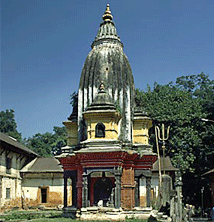
|
|
enter the
temple compound, but they can have a good view of the whole complex from a higher vantage point. Thousands of devotees gather in this temple during the Shivaratri festival.
|
|
|
|
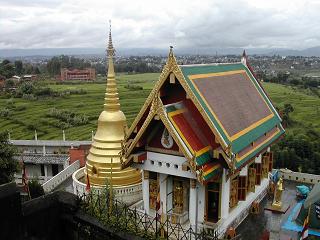
|
Kirtipur
The medieval town of Kirtipur is situated on a ridge to the southwest of Kathmandu. Kirtipur is a centre of cloth weaving and dyed yarn. The Ridge offers a panoramic view of Kathmandu with Himalayan peaks rising behind it. When Prithvi Narayan Shah conquered the Valley in the eighteenth century, Kirtipur put up a stiff resistance, causing heavy losses to the invading army. In order to avenge the death of his soldiers, the King cut off the noses of all able-bodied men in town. It is said that people in this town have their noses shorter than other Nepalese. The Tribhuvan University Campus is located at the foot of the hill. The Chobhar Gorge, a very scenic spot is located near Kirtipur. It is believed that gods cut this gorge to drain the water from the Kathmandu Valley when it was still a lake. The Buddhist temple of Adinath is situated on the top of the hill.
|
|
|
|
|
Budhanilkantha
Temple
The Budhanilkantha Temple is situated about 10 kms. north of Kathmandu. The main attraction of the temple is the world’s largest statue of the Vishnu, reclining on the bed of serpents in the pool. This temple belongs to the 8th century AD. No one knows who built the statue, but according to the legend it was accidentally unearthed by a farmer. The 5 m stone statue of Vishnu, holds four things in his four hands. These things are a discus (symbol of the mind), mace (primitive knowledge), conch (the 5 elements) and lotus seed (universe). According to the legend, the Lord Vishnu sleeps for four months of the year and the festival of Budhanilkantha is celebrated in the month of November, on account of the waking up of the god after a long sleep. Various devotees gather here in large number during the Haribodhini Ekadasi and Kartik Purnima.
Dakshinkali Temple
The Dakshinkali temple is dedicated to the goddess Kali and located in the southern edge of the Valley. The temple is about half an hour’s drive from Kathmandu. Many Nepalese families take a vow before the goddess that if their wish is fulfilled, they would offer the sacrifice. The goats are sacrificed in this temple to please the goddess. After the sacrifice, part of the meat is brought to the home for a feast.
Nagarkot
The Nagarkot village is situated near Kathmandu. It is the most popular place to view the Himalayas. Nagarkot is situated on the ridge to the north-east, and offers a view stretching from Dhaulagiri in the west to Kanchanjunga in the east. A better option would be to stay overnight at nagarkot and view the mountains at dawn. In recent years, Nagarkot has developed into a king of a resort.
Dhulikhel
Dhulikhel is another place to view the mountains, situated just outside Kathmandu Valley. Dhulikhel is located at an altitude of 1500 metres and view from here is considered better than Nagarkot. Dhulikhel is also the district headquarters and can be reached very easily. It offers a superb view of the Cho Oyu in the east to Himalchuli in the west.
Changu Narayan Temple
The Changu Narayan Temple is dedicated to Narayan (Lord Vishnu). This is a very popular temple visited by thousands of pilgrims. This temple is one of the finest and oldest specimens of pagoda architecture. Garuda, the mythical man-bird, which is the vahana (transport) of Lord Vishnu stands with folded hands in front of the temple.
Daman
Daman is the another place to view the mountains. The 8,000 feet pass of Simbhanjyang or Daman is situated along the main road leading to the Indian border. It is located about 120 km from Kathmandu. Although at lower altitude, some people believe that this is the best place to view the mountains. On a clear day, you can also view the Mount Dhaulagiri, Annapurna and Everest peaks. There is also a view tower fitted with long-range telescopes.
|
|
|
|
|
How to reach here
|
|
Today, Kathmadu is no more the distant Shangri La that it was. It is connected with various cities by air, rail and road.
By Air:
The Kathmandu airport is internationally connected by air with Bangkok, Kolkata, New Delhi, Mumbai, Bangalore, Varanasi, London, Paris, Moscow, Vienna, Dubai, Karachi, Dhaka, Paro, Lhasa, Singapore, Hong Kong, Shanghai and Osaka.
By Road:
The first surfaced road to reach Kathmandu, from Raxaul Bazar was completed in 1956. Kathmandu is also direct connected with East Uttar Pradesh, Lhasa in Tibet and Pokhara in the west. Modern highways connects Kathmandu with all the Himalayan cities like Darjeeling, Gangtok, Phuntsholing and various north-eastern states of India. The Arniko Highway connects Kathmandu with Tibet and China, via Kodari and Dolalghat in Nepal, through Tatopani (Liping) on the Nepal border and Lhasa in the Tibet. There are various entry points from where the tourists can enter into Nepal from India like Kakarbhitta, Birgunj, Belhiya, Kodari, Sunauli, Nepalgunj, Dhangadi and Mahendranagar.
By Rail:
The nearest railway station is located at Amlekhganj in the Terai region and linked with Raxaul Bazaar on the Indian border which is connected with Gorakhpur and Patna.
|
|
|
|
|
|